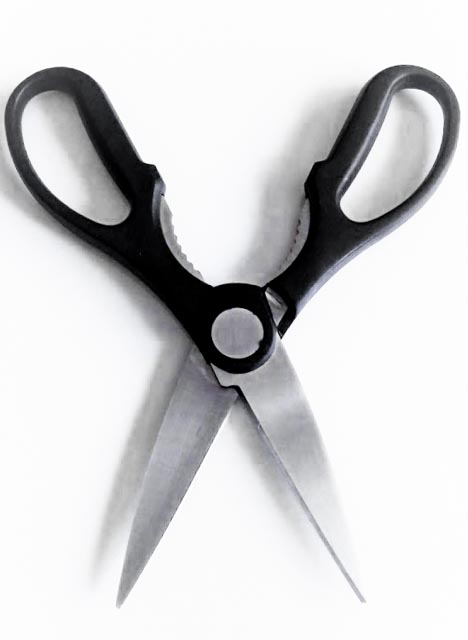NO… WE ARE NOT TRIMMING YOUR FAT! DON’T EVER TRY THAT AT HOME!
Don’t most of us wish we could shear some fat off our waist or hips with a snip or two? Well I do. But trimming the fat off a chicken is that easy.
Trimming the fat is made easier with kitchen shears
First, kitchen shears are NOT your average pair of scissors. They look similar, but in functionality they are not at all alike.
You should not expect regular scissors to do the job of kitchen shears. If you try, it is most likely your scissors won’t ever perform their intended task as well as they did before. That pin in the middle of the tool will expand, get loose and there is a good chance the 2 blades will never again meet close enough to do a good job cutting paper.
Kitchen shears are much sturdier than scissors. They are meant to cut through chicken bones, and they make light work of that. What they are not good for is cutting paper.
How much is too much fat?
I confess; I like meat fat. So you can be sure this discussion will not be one that expounds the virtues of lean meat. I am going to stick to giving you some tips about preparing chicken for a dinner recipe, by trimming off excess fat and skin.
And why would you want to do some trimming before you cook? A glob of chicken fat is not appealing in any way. And unless you are deep frying or roasting, excess chicken skin is limp and rubbery.
Recipes will call for chicken with “skin on” because that recipe will taste better. But like most things in life, there is a tipping point when too much, is not too good.
If you don’t remove the big globs of fat hanging off your chicken before cooking, those globs melt and leave all your other ingredients swimming around in chicken fat. It is hardly the homemade meal you are hoping for.
The fattiest of chicken pieces are whole chicken legs, so that is what we are using to demonstrate. Yes, trimming is an extra step in the preparation of your dinner. But there are some simple and quick things you can do prior to cooking, that are worth the time it takes. This is one of those things. You don’t have to be a pro. Just cut off the big globs of fat.
Here’s what I’m talking about
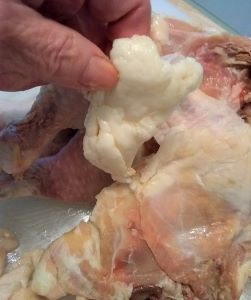
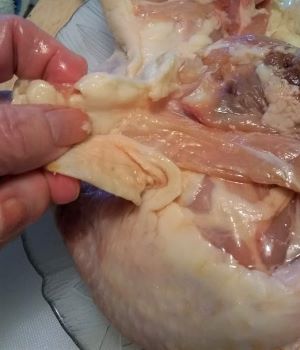
You probably don’t need me to tell you there is no good reason to keep the globs of fat and flabby skin on this chicken leg. 😝
Look at how easy it is to get off!
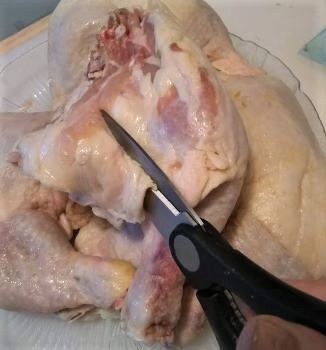
WARNING.....THE NEXT PICTURE WE ARE ABOUT TO SHOW YOU,YOU MAY FIND DISTURBING! it’s gross. Just remember, all the fat and skin that has been cut off, would have otherwise been melting into my cacciatore.
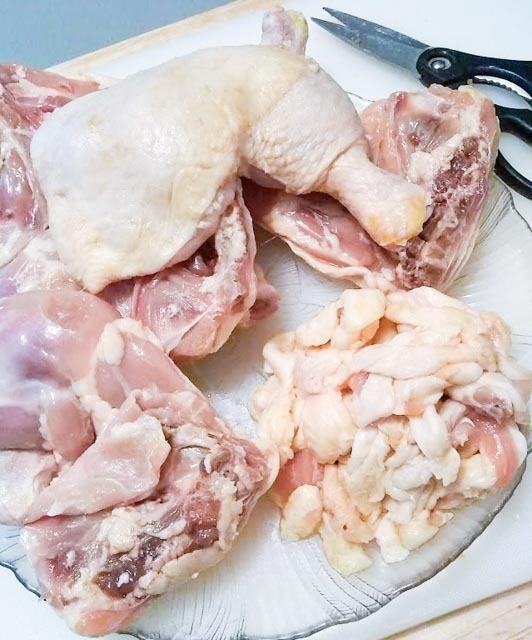
Isn’t that a mind blower?
In the picture above, I showed one leg with the skin side up. Each of the other legs have skin on the flip side too.
You can see that there are little bits of fat here and there on the inside of the legs. That’s fine. Also there is a thin layer of fat under the skin that helps add flavor. That little bit of fat is why certain recipes call for chicken with the skin on.
Leave it on the plate not in the pan
Take another look at that mound of chicken fat and excess skin. Don’t you agree that leaving that mound of fat and skin on the plate rather than adding it to the skillet is the way to go?
Would you want to pick up that pile of fat and skin and throw it into your skillet so you could eat it? Well, Lose it or Use it. Cut it or Cook it. Isn’t it worth the little time it takes to cut it off? Doesn’t it stand to reason that there would be a difference in the quality of the finished product, if you cut that mess of fat and skin off?
I am not trying to be a wise guy with those questions. I am just passing along this tip in case you never thought about trimming chicken in the past. You will choose for yourself if it is worth the little extra time to trim the fat off. If you are taking the time to cook, why not reward yourself with a great tasting meal.

